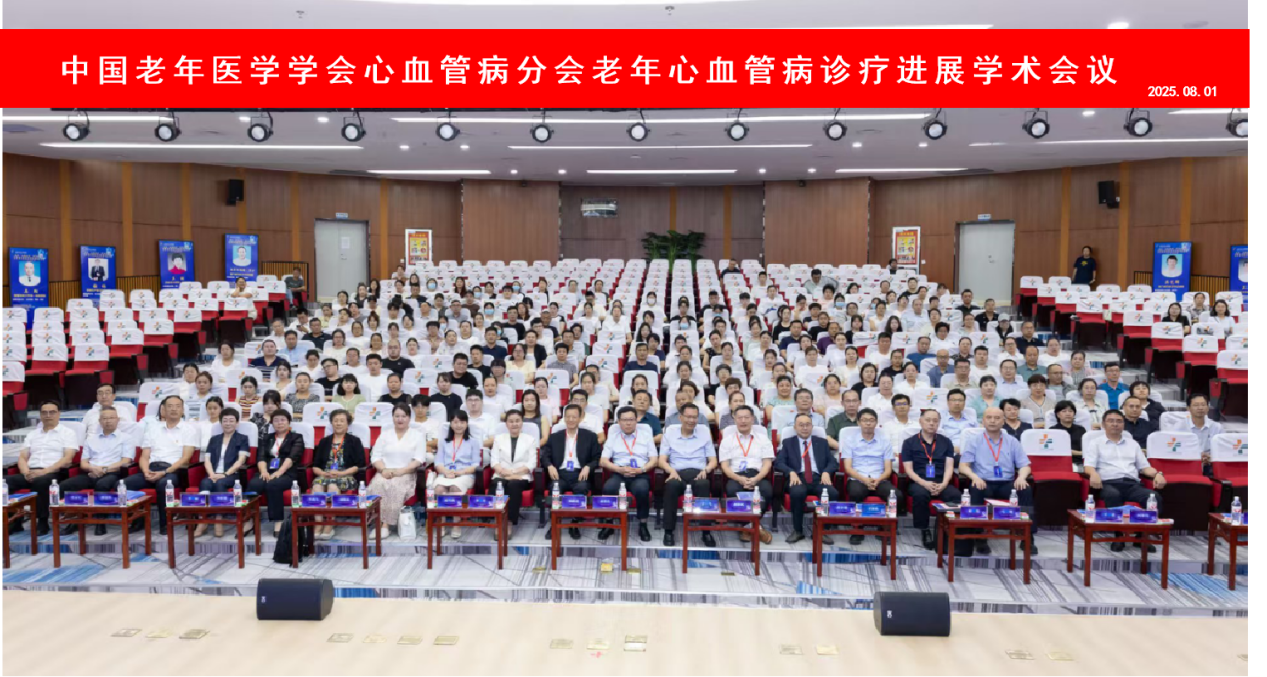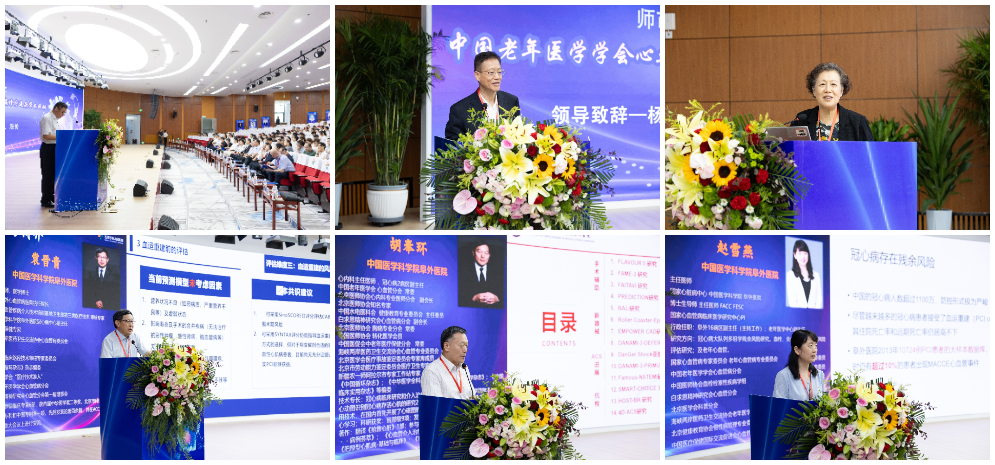The Academic Conference on the Progress of Diagnosis and Treatment of geriatric Cardiovascular Diseases of the Cardiovascular Disease Branch of the Chinese Geriatrics Society was successfully held in Shihezi City
On August 1, 2025, the Academic Conference on the Progress of Diagnosis and Treatment of Cardiovascular Diseases in the elderly, hosted by the Cardiovascular Disease Branch of the Chinese Geriatrics Society and organized by Shihezi People's Hospital, was grandly held in Shihezi City. This event brought together top experts in the field of geriatric cardiovascular diseases in China. Through authoritative interpretations, special topic discussions, case analyses and other forms, it brought cutting-edge diagnosis and treatment concepts and technical standards to border areas, demonstrating the responsibility and commitment of national medical societies to support the development of medical services in border areas. It has profound significance for improving the prevention and treatment level of geriatric cardiovascular diseases in the region.

At the opening ceremony, Li Ping, a member of the Standing Committee of the Party Committee of Shihezi City, the Eighth Division of Xinjiang Production and Construction Corps, deputy Political Commissar and Minister of Organization of the Eighth Division, Ding Yi, deputy commander of the Eighth Division of Xinjiang Production and Construction Corps, Liu Xiaojing, Party Secretary and Director of the Health Commission of the Eighth Division, and other leaders attended this event. He Xiongwei, the deputy secretary of the Party Committee and president of Shihezi People's Hospital, delivered the opening remarks first. He pointed out that with the acceleration of the aging process of the population, the incidence of cardiovascular diseases among the elderly in border areas has been increasing year by year. However, the relatively scarce high-quality medical resources and the gap in diagnosis and treatment technologies compared with those in the inland areas have become the bottlenecks restricting the development of the local health industry. The Cardiovascular Disease Branch of the Chinese Geriatrics Society has held a high-level academic event in Shihezi this time, providing a valuable learning and exchange platform for grassroots medical institutions. This is bound to promote the standardization of local diagnosis and treatment to a new level.
At the opening ceremony, leaders from the Health Commission of Shihezi and the city and division delivered speeches successively, expressing their gratitude to the Cardiovascular Disease Branch of the Chinese Society of Geriatrics for its support. They emphasized that this academic activity is a concrete practice of implementing the policy of sinking high-quality medical resources and hoped that local medical workers would cherish the learning opportunity and transform cutting-edge knowledge into clinical service capabilities.
Professor Yang Yuejin, president of the Cardiovascular Disease Branch of the Chinese Geriatrics Society and from Fuwai Hospital, Chinese Academy of Medical Sciences, said in his speech that supporting the medical construction in border areas is an important mission of the society. The Cardiovascular Disease Branch will continue to pay attention to the needs of border regions and help narrow the regional medical gap through various forms such as academic assistance and talent cultivation.


 During the academic lecture session, Professor Yang Yuejin, under the title of "Interpretation of Key Points of the Chinese PCI Guidelines (2025)", based on over 30 years of clinical experience, systematically sorted out the updated key points of the 2025 version of the guidelines in terms of the selection of interventional therapy indications, surgical operation norms, and postoperative management. By comparing typical cases, he deeply analyzed the optimization suggestions for the diagnosis and treatment strategies of complex coronary artery lesions in the new version of the guidelines, providing a clear clinical decision-making framework for primary care physicians. Professor Yuan Jinqing presented "Interpretation of the Expert Consensus on Revascularization for Ischemic Cardiomyopathy in 2025", providing authoritative guidance on the diagnosis and treatment challenges of ischemic cardiomyopathy that frequently occur in border areas, covering aspects such as the timing selection for revascularization, surgical method evaluation, and risk prevention and control. He particularly emphasized that primary care physicians should attach importance to the role of multidisciplinary collaboration in the diagnosis and treatment of complex cases. Professor Zhao Xueyan's lecture "The Latest Advances in Anti-inflammatory Treatment of Coronary Heart Disease in 2025" focused on new targets in the treatment of cardiovascular diseases, introducing the latest clinical evidence of anti-inflammatory treatment in the secondary prevention of coronary heart disease, and providing new ideas for individualized treatment of elderly patients. Professor Hu Fenghuan's "Clinical Research Progress of Coronary Heart Disease 2025" systematically reviewed the important clinical research achievements of the year and analyzed the guiding value of research evidence for clinical practice. Professor Li Nanfang, in light of the epidemiological characteristics of hypertension in Xinjiang region, interpreted the "Hypertension Guidelines 2025" and proposed prevention and treatment strategies that are in line with regional features. After each lecture, there will be a comment and discussion session. Professors Ma Xiang from the First Affiliated Hospital of Xinjiang Medical University, Xie Wei from the General Hospital of Xinjiang Production and Construction Corps, Wang Zhong and Wang Li from the First Affiliated Hospital of Shihezi University, and Nurbahati Heisha and Han Yihui from Shihezi People's Hospital will be present. Professor Li Hongjian from the Fifth Affiliated Hospital of Xinjiang Medical University and others served as the hosts and discussion experts of the academic session, engaging in in-depth exchanges with the attending physicians and sparking intellectual exchanges.
During the academic lecture session, Professor Yang Yuejin, under the title of "Interpretation of Key Points of the Chinese PCI Guidelines (2025)", based on over 30 years of clinical experience, systematically sorted out the updated key points of the 2025 version of the guidelines in terms of the selection of interventional therapy indications, surgical operation norms, and postoperative management. By comparing typical cases, he deeply analyzed the optimization suggestions for the diagnosis and treatment strategies of complex coronary artery lesions in the new version of the guidelines, providing a clear clinical decision-making framework for primary care physicians. Professor Yuan Jinqing presented "Interpretation of the Expert Consensus on Revascularization for Ischemic Cardiomyopathy in 2025", providing authoritative guidance on the diagnosis and treatment challenges of ischemic cardiomyopathy that frequently occur in border areas, covering aspects such as the timing selection for revascularization, surgical method evaluation, and risk prevention and control. He particularly emphasized that primary care physicians should attach importance to the role of multidisciplinary collaboration in the diagnosis and treatment of complex cases. Professor Zhao Xueyan's lecture "The Latest Advances in Anti-inflammatory Treatment of Coronary Heart Disease in 2025" focused on new targets in the treatment of cardiovascular diseases, introducing the latest clinical evidence of anti-inflammatory treatment in the secondary prevention of coronary heart disease, and providing new ideas for individualized treatment of elderly patients. Professor Hu Fenghuan's "Clinical Research Progress of Coronary Heart Disease 2025" systematically reviewed the important clinical research achievements of the year and analyzed the guiding value of research evidence for clinical practice. Professor Li Nanfang, in light of the epidemiological characteristics of hypertension in Xinjiang region, interpreted the "Hypertension Guidelines 2025" and proposed prevention and treatment strategies that are in line with regional features. After each lecture, there will be a comment and discussion session. Professors Ma Xiang from the First Affiliated Hospital of Xinjiang Medical University, Xie Wei from the General Hospital of Xinjiang Production and Construction Corps, Wang Zhong and Wang Li from the First Affiliated Hospital of Shihezi University, and Nurbahati Heisha and Han Yihui from Shihezi People's Hospital will be present. Professor Li Hongjian from the Fifth Affiliated Hospital of Xinjiang Medical University and others served as the hosts and discussion experts of the academic session, engaging in in-depth exchanges with the attending physicians and sparking intellectual exchanges.
At the end of the event, the branch selected a representative case of cardiovascular difficulty for case analysis and discussion. Through the interactive mode of "case report - expert analysis - plan optimization", it guided grassroots physicians step by step to enhance their clinical thinking ability. The attending physicians all expressed that the content of this academic activity was practical and highly targeted, and it had significant guiding significance for their future clinical work.

The successful holding of this academic event is not only a transmission of cutting-edge knowledge, but also a vivid practice of the Cardiovascular Disease Branch of the Chinese Geriatrics Society in supporting medical care in border areas. Taking this event as a starting point, the society will establish a long-term assistance mechanism and continuously empower through remote academic lectures, expert on-site guidance and other means, contributing professional strength to promoting the development of elderly health in border areas and advancing the construction of a Healthy China.
Prev
Exploring New Paradigms of AI Empowering Brain Science Research - The 2025 NeuroImaging and Artificial Intelligence Academic Conference of the Radiology Branch of the Chinese Geriatrics Society was Held in Beijing
Next
The Fourth Academic Conference on Geriatric Nephrology of the Chinese Society of Geriatrics was successfully held in Beijing

